Types of Business Meetings and How to Run them Effectively
What is a Business Meeting?
Today, businesses must negotiate with a variety of different individuals and groups in order to be successful. These negotiations may take place with customers, suppliers, employees, shareholders, or government officials. Each negotiation presents unique challenges and opportunities.
Business meetings are an opportunity for management to convey the main goals, and objectives to all departments at once, get feedback and, based on the data obtained, adjust the action plan for the company. Businesses that are able to successfully negotiate win greater profits, improved relationships, and a competitive edge.
A few years ago, such meetings were held only in person, but with the growth of information technology companies can hold business meetings remotely via video conferencing.
The Importance of Business Meetings
Business meetings play a vital role in managing any organization’s trajectory towards success and expansion. They function as arenas for communication, collaboration, decision-making, and strategic planning, holding significant importance in various aspects:
- Communication: Meetings offer a structured setting for effective communication among team members, departments, and management tiers. Through in-person discussions, ideas, updates, concerns, and feedback can be exchanged promptly, promoting clarity and unity within the organization. Moreover, a strong command of business English can enhance this communication, ensuring that all parties understand and engage in discussions effectively.
- Collaboration: Such meetings foster collaboration by bringing together people with different skills and perspectives. You can have meetings even with your outsourced team since their time zones align for real-time interactions. Attendees can generate ideas collectively, address challenges together, and strive towards shared objectives, thereby encouraging innovation and improving outcomes. By effectively leveraging collaboration in business meetings, teams located across different states can better negotiate commercial contracts. For example, residents of Chicago seeking legal advice for significant contracts often consult a local commercial contracts lawyer to navigate complex negotiations.
- Accountability: By defining clear objectives, assigning tasks using an employee management app, and monitoring progress, meetings instill accountability within the organization. This ensures that individuals and teams are accountable for their actions, fostering a culture of responsibility.
- Strategic Planning: Business meetings provide a space for strategic discussions and goal setting. Leaders utilize these opportunities to evaluate past performance, analyze market trends, identify opportunities and threats, and strategize for the future. Through careful planning, organizations can adapt to evolving circumstances, capitalize on emerging trends, and maintain competitiveness. Furthermore, utilizing industry-specific templates can enhance the effectiveness of these meetings. For example, if you operate a dispensary business, referring to your dispensary business plan can provide tailored insights and strategies for your industry.
- Feedback and Improvement: Meetings facilitate the exchange of feedback, both formal and informal. Whether through performance evaluations, project updates, or process assessments, meetings enable constructive critique that supports ongoing improvement endeavors. By receiving input from stakeholders, organizations can identify areas for improvement and make necessary adjustments.
Types of Business Meetings
One-on-one meeting
Personal discussions, commonly referred to as one-on-one meetings, are held between two people in the company, most frequently managers and a member of their team, but can also include colleagues at different levels. These meetings offer a special environment for communication, feedback, and personal development.

The benefits of one-on-one meetings are numerous:
- Tailored Communication: Individualized discussions allow the needs, concerns and aspirations of each participant to be addressed.
- Feedback and Assistance: Managers can provide constructive criticism on performance, acknowledge accomplishments, and offer guidance for improvement, thereby aiding in the professional development of their team members.
- Goal Setting and Coordination: One-on-one meetings provide an opportunity for managers and employees to discuss and synchronize individual goals.
- Cultivating Trust and Bonds: Regular one-on-one meetings build trust and understanding between managers and staff.
Team building meetings
Team building is a meeting aimed at improving teamwork. Such meetings are a critical component in creating a strong company culture that leads to increased productivity. For big companies with multiple offices, team building can be a great opportunity for colleagues to get to know each other better.
Meetings focused on team building provide many benefits for both individuals and the team as a whole. Here are some of the advantages:
- Enhanced communication: By encouraging open communication, team-building meetings promote better collaboration, understanding, and problem-solving among team members.
- Greater trust: Through participating in team building activities, team members develop trust in each other, which results in a more productive and cohesive team.
- Improved problem-solving abilities: Team building activities often require team members to work together to solve problems, helping them develop their problem-solving skills.
- Boosted morale: Team building meetings can increase morale by creating a fun and interactive environment that fosters positive social interaction and relationships.
- Increased productivity: When team members feel comfortable working together and have strong communication skills, productivity tends to increase as they can more effectively collaborate and work using project management tools towards common goals.
Overall, team-building meetings provide a positive impact on the team’s performance, morale, and relationships. Through effective planning and execution, team-building meetings can be a valuable investment for any organization. For companies looking to streamline operations amidst tight schedules, discovering affordable solutions such as meal delivery services can be quite useful. There are numerous benefits in considering pre-prepared meals options, not least is the cost advantage and time savings discussed under green chef promotions. Ensuring everyone stays nourished and healthy could significantly improve productivity during tight business meetings schedules.
Innovation meetings
The idea of innovation meetings is based on promoting new ideas by sharing information between participants. Innovation meetings often begin with out-of-the-box thinking, brainstorming, connecting, and sharing ideas on a large scale. For example, in the field of app development, such meetings are indispensable.
Meetings focused on innovation offer many benefits to organizations and teams. In addition to effective communication and collaboration tools, having the right software for document management is crucial during business meetings. Managing technical documents or large format files can be especially streamlined with the help of real-time screen sharing, making it easier to annotate and review plans effectively.
Here are some of the advantages of such meetings:
- Fresh ideas: Innovation meetings bring together individuals with diverse perspectives and skill sets, resulting in the generation of new ideas, brainstorming product development or marketing campaigns and innovative.
- Improved collaboration: Innovation meetings encourage collaboration and teamwork, leading to better communication, understanding, and trust among team members. Whether you are running an e-commerce that assists people with selling online or evolving in any other field, this type of meeting meetings keeps things running smoothly.
- Stimulated creativity: By creating a supportive and inclusive environment, innovation meetings inspire individuals to unleash their creativity and think outside the box like having your staff wear custom hoodies to get your brand name out.
- Enhanced decision-making: Innovation meetings provide a structured process for evaluating ideas and making decisions, leading to better outcomes and results for the organization or team.
Overall, innovation meetings are a powerful tool for organizations looking to stay competitive and drive growth. By fostering creativity, collaboration, and problem-solving, innovation meetings can help teams develop new ideas and approaches that lead to better outcomes and results.
Information sharing meetings
Information sharing meetings play a vital role in disseminating knowledge, updates, and insights in an organization. In such meetings, stakeholders share vital information covering various aspects such as project progress, market trends, company-wide announcements, and strategic initiatives.
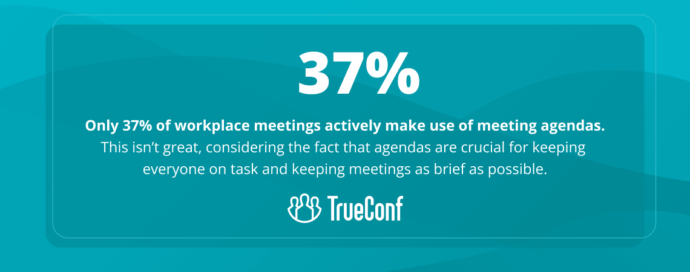
Here are some key benefits of information sharing meetings:
- Enhanced Decision-Making: These gatherings speed decision-making processes by providing stakeholders with up-to-date information. In this way, all key leaders can make more informed choices, seize opportunities, and efficiently address challenges.
- Knowledge Transfer: Such meetings allow staff to share best practices, lessons learned and knowledge gained during the course of their work. This facilitates skills and competencies development for all participants.
- Promoting Innovation: Through the dissemination of information concerning market trends, customer feedback, and emerging technologies, these meetings stimulate creativity and the exploration of new ideas or opportunities.
In conclusion, information exchange meetings play a vital role in fostering transparency, collaboration, innovation, and alignment within organizations, thereby contributing to their success and long-term viability.
Status update meetings
Status update meetings are regular project meetings where team members agree on their progress toward a common goal, reporting on current updates, task progress, challenges, and next steps. These meetings are particularly important in the construction industry with tight timelines and complex workflows.
Group activities in such meetings usually include problem-solving, decision-making, prioritizing, and assigning tasks. It is useful to use reports, graphs, and goal setting worksheets to keep the team updated. You can use reporting tools (see, e.g., Supermetrics pricing) to pull all of your marketing data together, for example.
Status update meetings are a crucial tool for keeping teams informed about project, task, and goal progress. Here are some of the benefits that status update meetings offer:
- Timely issue identification: Regular progress reporting enables team members to detect potential issues early on, facilitating prompt intervention and resolution.
- Better decision-making: Status update meetings offer a platform for discussing issues and making decisions based on up-to-date data and information.
- Increased motivation and engagement: Status update meetings provide an opportunity to acknowledge successes, recognize achievements, and offer feedback, which can improve morale and increase motivation and engagement among team members.
Decision-making meetings
In a decision-making meeting, a group of people come together to make a decision. The group may use a variety of methods to make the decision, including voting, consensus, or a majority vote. In a majority vote meeting, the group votes on a proposal and the proposal is accepted if it receives more than half of the votes.
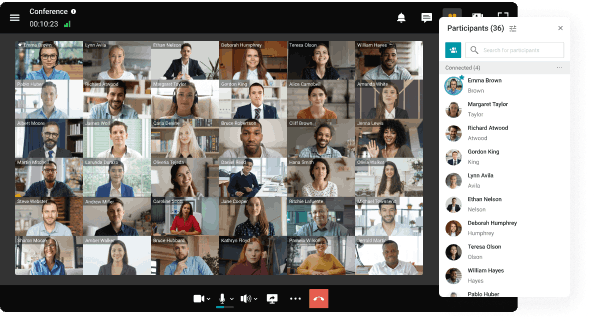
Meetings focused on decision-making are a crucial tool for teams and organizations to make informed choices and take action. Here are some of the benefits that decision-making meetings offer:
- Clarity and agreement: Decision-making meetings provide a platform for team members to discuss and clarify issues, fostering a shared understanding and agreement on the best course of action.
- Improved decision quality: By gathering diverse perspectives and expertise, decision-making meetings can enhance the quality of decisions made, resulting in better outcomes.
- Increased efficiency: Decision-making meetings offer a structured process for making decisions, which can save time and reduce the risk of indecision or delay.
- Accountability: By involving team members in the decision-making process, decision-making meetings help to establish accountability and ownership for the outcomes.
Problem-solving meetings
These are the most common type of business meetings, whether for a startup team, a well-established agency, or a global enterprise. A problem-solving meeting is a meeting in which a group of people comes together to brainstorm and come up with a solution to a problem.
This type of meeting is often used in workplaces when a team needs to come up with a way to solve a specific issue. In order to generate the most productive ideas, it’s important to encourage all participants to share their thoughts, and to avoid judging or criticizing any suggestions.
The goal of a problem-solving meeting is to come up with a solution that everyone can agree on. Once a solution is reached, it’s important to put a plan in place to make sure that the solution is actually implemented. This type of meeting is especially important in small businesses, as the solutions reached can have a significant impact on the organization and its employees. Once a solution is reached, it’s crucial to put a plan in place to make sure that the solution is actually implemented, and the problem is fully resolved. You can convert scanned documents and even extract text from image with advanced OCR technology by using a free image converter. This will help to make the meeting more productive for the participants. Extract the relevant information to explain the meeting points to the audience. This makes the brainstorming easy for the participants in a meeting. Participants can understand easily what the purpose of calling the meeting.
Meetings focused on problem-solving are a vital tool for organizations to overcome challenges and find effective solutions. Here are some of the benefits that problem-solving meetings can offer:
- Identification of underlying causes: Problem-solving meetings offer a platform for team members to identify the root causes of a problem, rather than just addressing its symptoms.
- Collaboration: Problem-solving meetings bring together diverse perspectives and expertise, fostering more creative and effective solutions.
- Structured approach: Problem-solving meetings provide a structured approach to addressing problems, helping to avoid impulsive or ineffective solutions.
- Increased commitment: By involving team members in the problem-solving process, problem-solving meetings can increase commitment and ownership for the solutions.
Overall, problem-solving meetings are an effective tool for organizations looking to address challenges and find solutions. By providing a structured process for collaboration and communication, problem-solving meetings can help to identify root causes, increase buy-in, and improve outcomes.
Strategic Management Meetings
These types of meetings are crucial events held within organizations, acting as central hubs where discussions, elaborations, and implementations of strategies occur to drive the achievement of overarching goals and objectives over the long term.
There are several benefits associated with strategic management meetings:
- Alignment: Strategic management meetings ensure that all stakeholders are united around the vision, mission and overarching goals of the organization. By convening key decision makers, these meetings clarify goals and ensure a concerted effort to achieve shared strategic priorities.
- Resource Optimization: Strategic management meetings empower leaders to distribute resources—be it budgetary, personnel, or temporal—in consonance with strategic imperatives.
- Risk Management: Through strategic management gatherings, leaders can pinpoint and evaluate potential risks and hurdles facing the organization. By discussing risk mitigation strategies and contingency plans, these meetings mitigate uncertainty and strengthen the organization’s resilience to adversity.
- Stakeholder Buy-In: These meetings provide an opportunity to engage stakeholders, such as employees, customers, and shareholders, in the strategic planning process. By soliciting feedback and input from relevant stakeholders, leaders can build consensus and secure buy-in for strategic initiatives.
In summary, strategic management meetings play a critical role in shaping the future of the organization by aligning stakeholders, making strategic decisions, allocating resources, managing risks, fostering innovation, evaluating performance, promoting accountability, securing stakeholder buy-in, and ensuring long-term sustainability. By investing time and resources in strategic management meetings, organizations can navigate complexity, seize opportunities, and achieve their long-term goals and objectives.
Learning workshops
Training workshops are interactive sessions designed to enhance participants’ knowledge, skills and capabilities on specific topics or areas of interest. Such meetings often include hands-on activities, discussions, presentations and collaborative exercises aimed at learning and professional development. These sessions can be an integral part of digital transformation solutions, empowering teams to embrace new technologies effectively.
Here are some of the benefits of learning workshop meetings:
- Knowledge Acquisition: Workshops allow participants to gain new knowledge, insights and information on a variety of topics. Through presentations, discussions and interactive sessions led by experts in the field, participants gain valuable insights and perspectives that can be applied to their work.
- Professional Growth: Participating in seminars can foster personal and professional growth by providing opportunities for continuous learning and development. Whether it’s earning new certifications, acquiring specialized skills, or learning about industry trends, seminars support career development goals.
Overall, training workshops provide many benefits to both participants and organizations, including skill development, knowledge acquisition, networking, problem-solving, professional growth, team building.
Training Sessions
Training session meetings are structured gatherings within an organization aimed at imparting specific knowledge, skills, or competencies to employees. These meetings can cover a wide range of topics, including technical skills, job-related procedures, compliance regulations, soft skills, and professional development.
Here are some of the benefits of training session meetings:
- Skill Development: Training session meetings provide employees with opportunities to enhance their skills and knowledge in specific areas relevant to their roles or career development. Whether it’s learning new software, mastering a particular process, or improving communication skills, these sessions contribute to individual growth and proficiency.
- Improved Performance: By equipping employees with the necessary skills and knowledge, trainings can lead to improved performance in their roles. Employees are better equipped to handle tasks efficiently, make informed decisions, and deliver high-quality work, ultimately contributing to overall productivity and effectiveness.
- Adaptability and Innovation: Training session meetings help employees stay updated on industry trends, best practices, and emerging technologies, fostering adaptability and innovation within the organization. Employees who are knowledgeable about the latest advancements are better equipped to adapt to changes and contribute innovative ideas to the organization.
- Consistency and Compliance: Training session meetings ensure consistency in processes, procedures, and compliance standards across the organization. By providing employees with training on relevant regulations and policies, organizations can mitigate risks, maintain compliance, and uphold standards of quality and integrity.
How does the Online Meeting Run?
The online meeting will run according to the agenda that has been created. Each participant will be given the opportunity to speak and share their ideas. The meeting will be moderated by the meeting organizer, who will ensure that the meeting runs smoothly and on schedule.
However, the meeting via the Internet is not limited to communication only. There are other features available as well:
- Slideshow. Employees can use slides on different topics and share them with colleagues.
- Screen sharing. When one participant starts screen sharing, the others can view the desktop content.
- Instant messaging. Participants can share text messages, files, impressive images, and videos.
- Polling. A quick way to vote on a particular issue and make a final decision.
- Meeting recording. If any participants miss a meeting or parts of a meeting, they can review the recording of the meeting later.
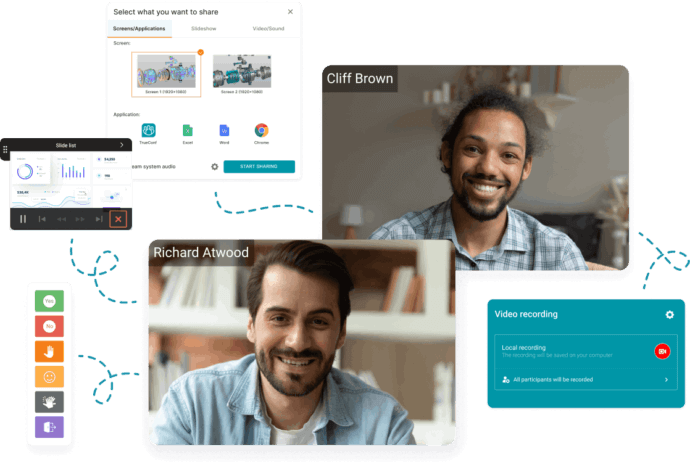
Business Meeting Icebreakers
Icebreakers are a great way to create understanding in a remote environment and foster relationships, collaboration and inclusivity in your distributed team. This can help meeting attendees feel more comfortable and get them to open up during the meeting. A business meeting moderator can ask people questions to get to know them or ask fun questions to create a more comfortable environment overall.
Using icebreakers in remote meetings is a must if a head of a company wants to build rapport with a distributed team. But what do those icebreakers look like in action?
Some examples of icebreakers questions:
1. What’s your favorite snack / food?
2. What’s your spirit animal?
3. What’s your favorite part of your job — and why?
4. What’s your favorite hobby?
5. Share a unique fact from childhood
Building rapport is always important, but it’s especially important when managing a remote or distributed team.
How to Organize a Business Meeting
1. Choose a Video Conferencing Solution
When running online business meetings, it’s important to choose the right video conferencing solution to meet your company’s needs. For instance, TrueConf offers a dedicated virtual meeting mode that allows moderators to control participant roles and visibility, ensuring structured and efficient discussions.
TrueConf offers extremely useful features for your business meetings:
- Ease of use. The solution interface is extremely user-friendly and intuitive.
- Unified communications. TrueConf provides all types of communication required for your team, including video conferencing, instant messaging, address book, presence statuses, VoIP integration and much more.
- Collaboration tools. During video conferencing users can enjoy multiple collaboration tools, such as remote desktop control, slideshow, screen sharing and recording.
- Data security. All sensitive data is stored locally, making TrueConf completely secure, which is especially important in the business industry.
- Technical support. TrueConf offers its customers exclusive high-quality technical support that will promptly solve any problems with the video conferencing system and answer any additional questions.
Take your team communication to the next level with TrueConf!
A powerful self-hosted video conferencing solution for up to 1,000 users, available on desktop, mobile, and room systems.
2. Establish the Purpose
Begin by clearly identifying the objectives and topics that require discussion. This will assist you in setting an agenda that keeps the meeting focused and productive.
3. Invite Participants
Determine the individuals who need to attend based on their roles and expertise. Send out invitations that are welcoming and include essential details such as the date, time, location, and any pre-meeting materials that are necessary.
4. Prepare Materials
Gather all the required materials, including presentations and business reports, and organize them accordingly. Develop a well-structured agenda with allocated time slots for each item and share it with the participants in advance.
5. Arrange the Meeting Space
Create a comfortable and inviting meeting environment. Organize the seating in a manner that encourages interaction and ensure that any audiovisual equipment or technology is functioning properly. It is also important to provide participants with materials like agendas and notepads.
6. Commence the Meeting
Start by warmly welcoming all attendees and introduce yourself if necessary. Provide a brief overview of the meeting’s purpose and agenda. If feasible, designate someone to take notes during the meeting to capture important points and action items.
7. Facilitate the Discussion
Stay on track by adhering to the agenda and actively involving the participants. Encourage their input, ask questions, and utilize visual aids to enhance engagement and comprehension during the discussion.
8. Foster Participation
Foster a friendly and inclusive environment where everyone feels comfortable sharing their thoughts. Allocate time for questions, comments, and discussions. Respect differing viewpoints and encourage participants to contribute their expertise and ideas. Encourage the sharing of start-up ideas to inspire innovation and fresh perspectives, ensuring a dynamic and collaborative atmosphere that drives growth and creativity.
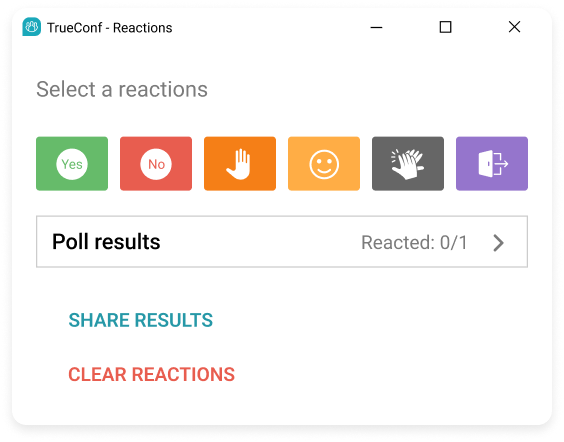
9. Summarize and Conclude
Towards the end of the meeting, summarize the key points and decisions that were made, and gather feedback by allowing participants to ask questions or present ideas. Clarify any action items and deadlines, express gratitude to the participants for their valuable contributions, and emphasize the importance of the discussion.
How to conclude a business meeting
When finishing a business meeting, it’s very important to get feedback from employees. Some of them may have additional questions, some may want to suggest alternative solutions to a business problem.
Meeting managers can enhance the experience by sharing additional materials or a recording of the corporate video meeting.
At the very end of the meeting, thank the participants for their time and attention. This will help build positive relationships by showing your team members that you appreciate and respect them and their time.
10. Follow Up
After the meeting, distribute the meeting minutes or a summary to all participants. Include any relevant attachments or documents. If the gathering involved shared experiences or moments worth capturing—such as during workshops, team retreats, or hybrid events—event photo sharing with QR code makes it easy to collect visual content from attendees instantly, without relying on scattered messages or manual uploads. Follow up on action items and offer support if necessary. Take the time to evaluate the meeting’s effectiveness and gather feedback to enhance future meetings.
In the case of webinars or conferences with unfamiliar participants, utilizing registration form can simplify the process of collecting leads for further processing. These templates not only save time but also ensure accuracy and consistency when collecting data from users across various online platforms if not using web scraping solutions. And if your lead collection relies on scraping public sources, working with best proxy providers helps you gather data at scale while keeping requests stable and reducing the risk of blocks. For those relying on automation, it’s essential to implement techniques for web scraping without getting blocked to maintain uninterrupted data collection and avoid IP bans.
By following these steps, you can conduct a welcoming, well-structured, and productive business meeting that successfully achieves its objectives while keeping all participants actively engaged.
Conclusion
Of course, online meetings cannot completely replace face-to-face meetings. However, they are especially relevant for online business and companies with several branches or representative offices. After all, employees can discuss current tasks and problems without leaving the office. This greatly saves employees’ time and reduces the company’s costs.
The key to the success of an online meeting is thorough preparation, strict adherence to the rules, and a quality video meeting platform. Follow the right tips for your company and hold successful business meetings!
About the Author
Diana Shtapova is a product specialist and technology writer with three years of experience in the unified communications industry. At TrueConf, she leverages her deep product expertise to create clear and practical content on video conferencing platforms, collaboration tools, and enterprise communication solutions. With a strong background in product research and user-focused content development, Diana helps professionals and businesses understand core product features, adopt new technologies, and unlock the full potential of modern collaboration software.



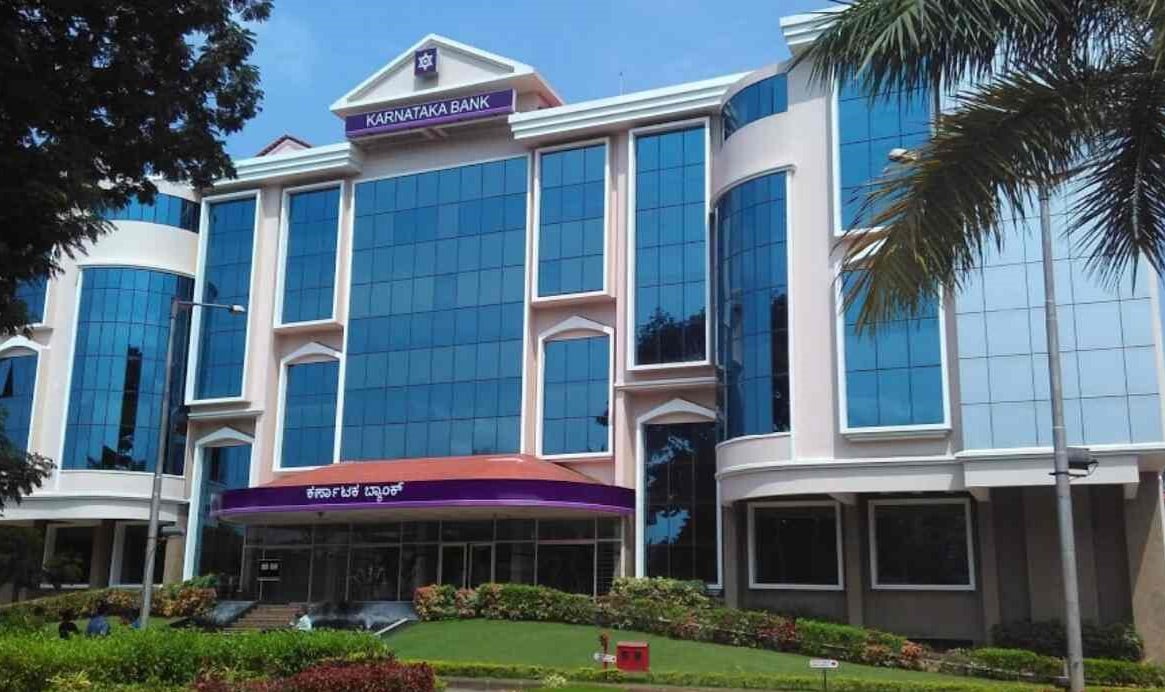

Follow us on social networks